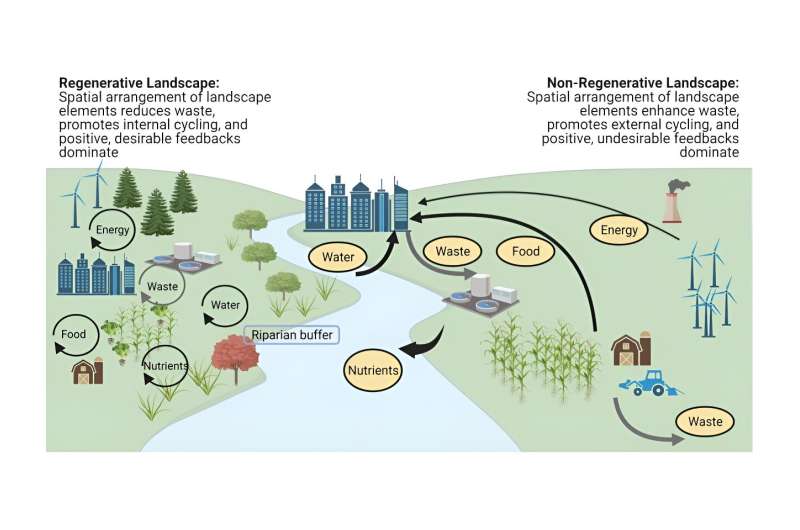This article has been reviewed according to Science X's editorial process and policies. Editors have highlighted the following attributes while ensuring the content's credibility:
fact-checked
peer-reviewed publication
trusted source
proofread
Collaborative landscape design approach may improve resiliency, human well-being

A newly proposed landscape stewardship framework may lead to a more resilient and adaptable environment and improved quality of life for people. Called regenerative landscape design (RLD), the approach was recently developed by a multi-institution collaboration led by Penn State researchers to enhance sustainability and better address complex and interconnected environmental and social challenges, such as climate change, biodiversity loss and social inequality.
Erica Smithwick, a distinguished professor of geography in the College of Earth and Mineral Sciences, is the lead author of the paper, which was published in the journal Ecology and Society.
"The socio-environmental challenges that we face today are intricately intertwined," Smithwick said. "However, the existing frameworks that strive to bring about change in areas such as resilience, landscape ecology, architecture, agriculture and geography are often compartmentalized and disciplinary. They often fall short of adequately addressing the social and scientific intricacies. Regenerative landscape design integrates a cross section of knowledge systems that guides solutions to resilient and stabilized answers that truly benefit people."
Smithwick said the three elements of RLD—regenerative systems, landscape approaches and collaborative design—have been individually explored in multiple disciplines, but this is the first time they were analyzed collectively. The research team's effort resulted in the development of RLD, a framework to guide intentional collaboration aimed at improving both the environment and society and to address the shortfalls of siloed approaches, according to Smithwick.
The intention, Smithwick said, is that researchers can apply RLD to complex, interconnected environmental and social challenges to develop solutions that are inclusive, comprehensive and scalable.
In a regenerative system, the changes that are made result in more giving than taking and a net positive toward a desirable outcome—it is a step beyond sustainability.
Landscape approaches allow for managing social-ecological systems because landscapes are large enough to capture the relationships between people and the environment, but small enough to be manageable. Landscapes also display social patterns and connect different disciplines.
Lastly, the focus on design—specifically co-design—emphasizes cooperation and facilitated teamwork. Landscapes are made up of various parts that work together, and they can be fashioned in a way that improves the environment.
Co-author Lisa Iulo, associate professor of architecture and director of the Hamer Center for Community Design, said RLD allows people to create positive environmental and societal change together.
"Regenerative landscape design works with affected communities to address complex and interconnected challenges," Iulo said. "RLD defines a process for people to design collaboratively. It brings together multiple disciplines with community experts to ensure research questions are grounded in the reality of place, establishing local and globally applicable solutions for regenerative built environments. RLD is inclusive and enlightening, recognizing people as an integral part of the landscape."
Leland Glenna, a professor of rural sociology and science, technology and society in the College of Agricultural Sciences, is also a co-author on the paper. He said the deficit model, which suggests the public is disconnected from such work because they do not understand or know enough to support the science, is a top-down approach that can fall short when developing solutions.
"Social and biophysical scientists are increasingly recognizing that the deficit model fails to capture why lay audiences might fail to understand or even resist efforts to promote societal change that would promote regenerative ecological outcomes," Glenna said. "Regenerative landscape design operates on the premise that two-way communication is needed between experts and stakeholders to fully understand the social, ethical and biophysical dimensions of problems and to develop comprehensive strategies for solving problems."
In addition to changes to research methods, the structure that supports the research enterprise needs to evolve, according to Smithwick, who is also the associate director of the Institute of Energy and the Environment.
"The mechanisms that are currently in place to review, fund and implement research are limited in how they can acknowledge or support co-design approaches such as RLD," she said. "The system must be able to recognize that there are alternative ways of knowing, including Indigenous worldviews and alternative solutions outcomes."
In the paper, the team provided examples of how regenerative landscape design could be applied in practice around the world. In the Chesapeake Bay area, the framework could be used to restore oyster reefs and other coastal habitats. In the example, intertwined issues such as extreme weather and flooding, regional economic needs, cultural and historical values and water quality are addressed collectively.
The research team explained how RLD could provide opportunities for collaborative design of optimal land-use plans that restore and enhance water quality while adding value to communities through flood protection. They also shared how participatory research with landowners could help identify the social, environmental and economic goals of potential restoration activities.
In Kenya, the researchers said, RLD could be used to create more sustainable agropastoral landscapes, which is land that accommodates both growing crops and raising livestock. In this example, the research team described systems that not only withstand future challenges like locust plagues or climate change, but also actively work towards a better state by addressing past land-use mistakes and considering both social and environmental factors.
"Regenerative landscape design is a new frontier in systems science, one that is rooted in collaboration, ethics and a deep understanding of the interconnectedness of social and natural systems," Smithwick said. "It is a call to action for us to work together to create landscapes that are more resilient, equitable and sustainable."
More information: Erica Smithwick et al, Regenerative landscape design: an integrative framework to enhance sustainability planning, Ecology and Society (2023). DOI: 10.5751/ES-14483-280405
Journal information: Ecology and Society
Provided by Pennsylvania State University





















